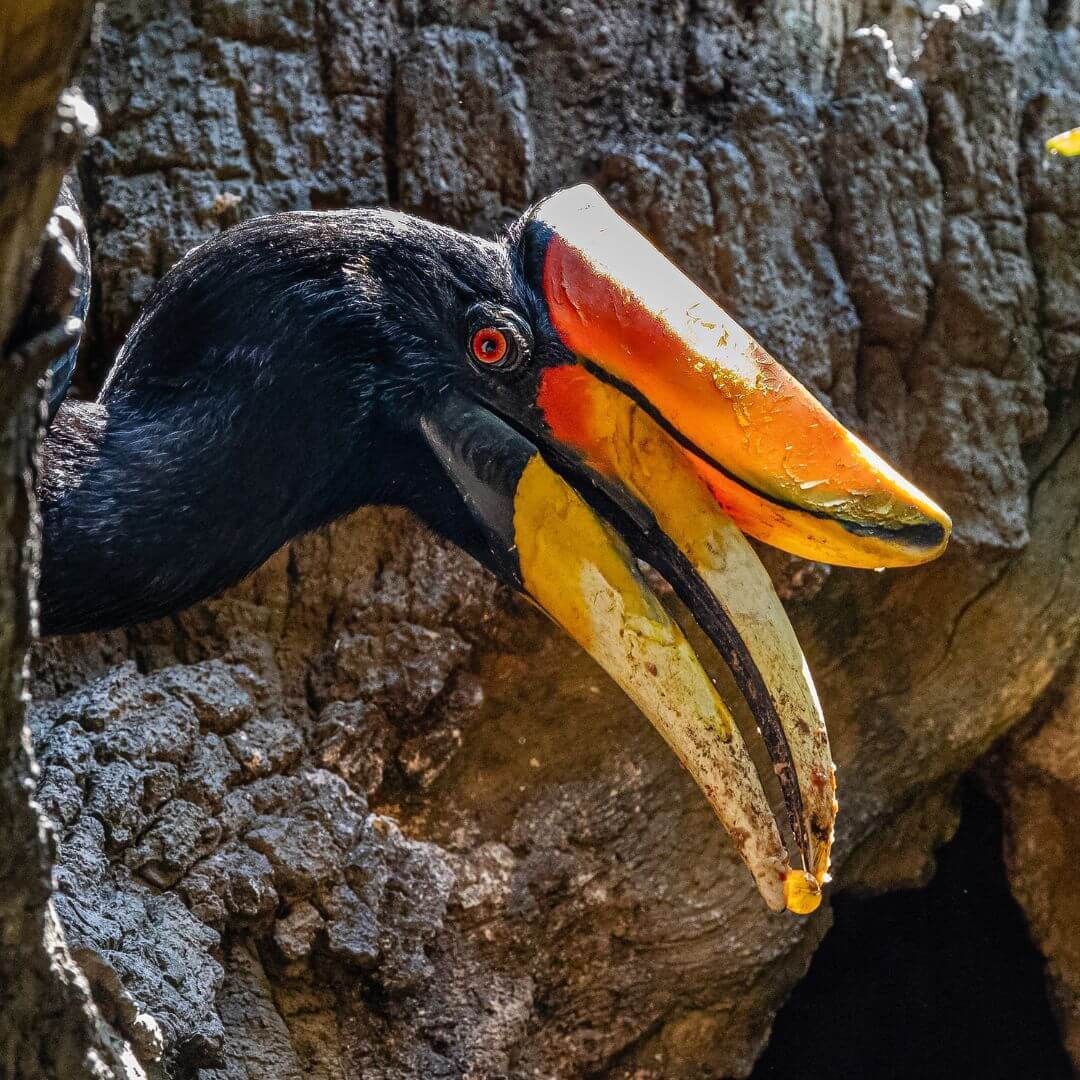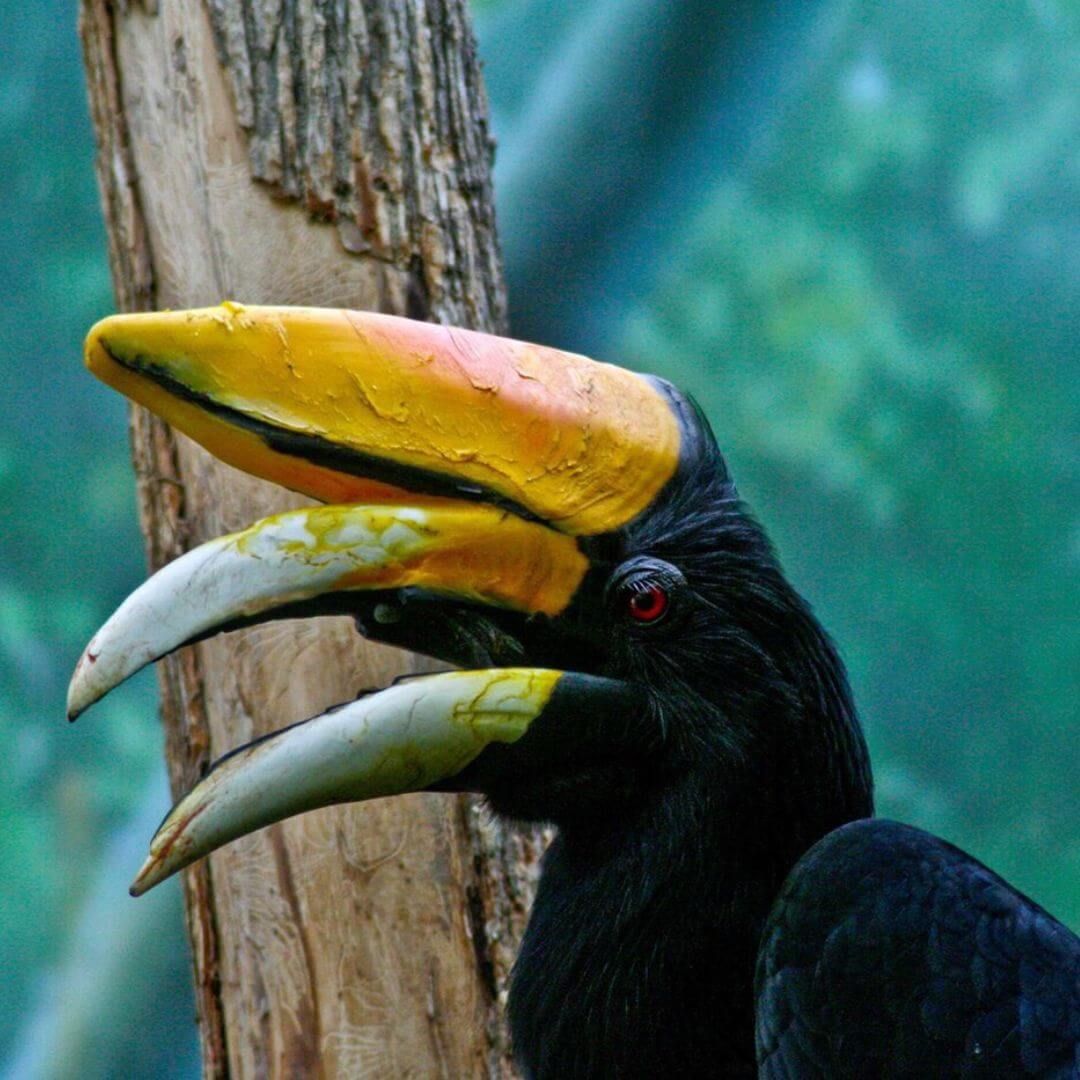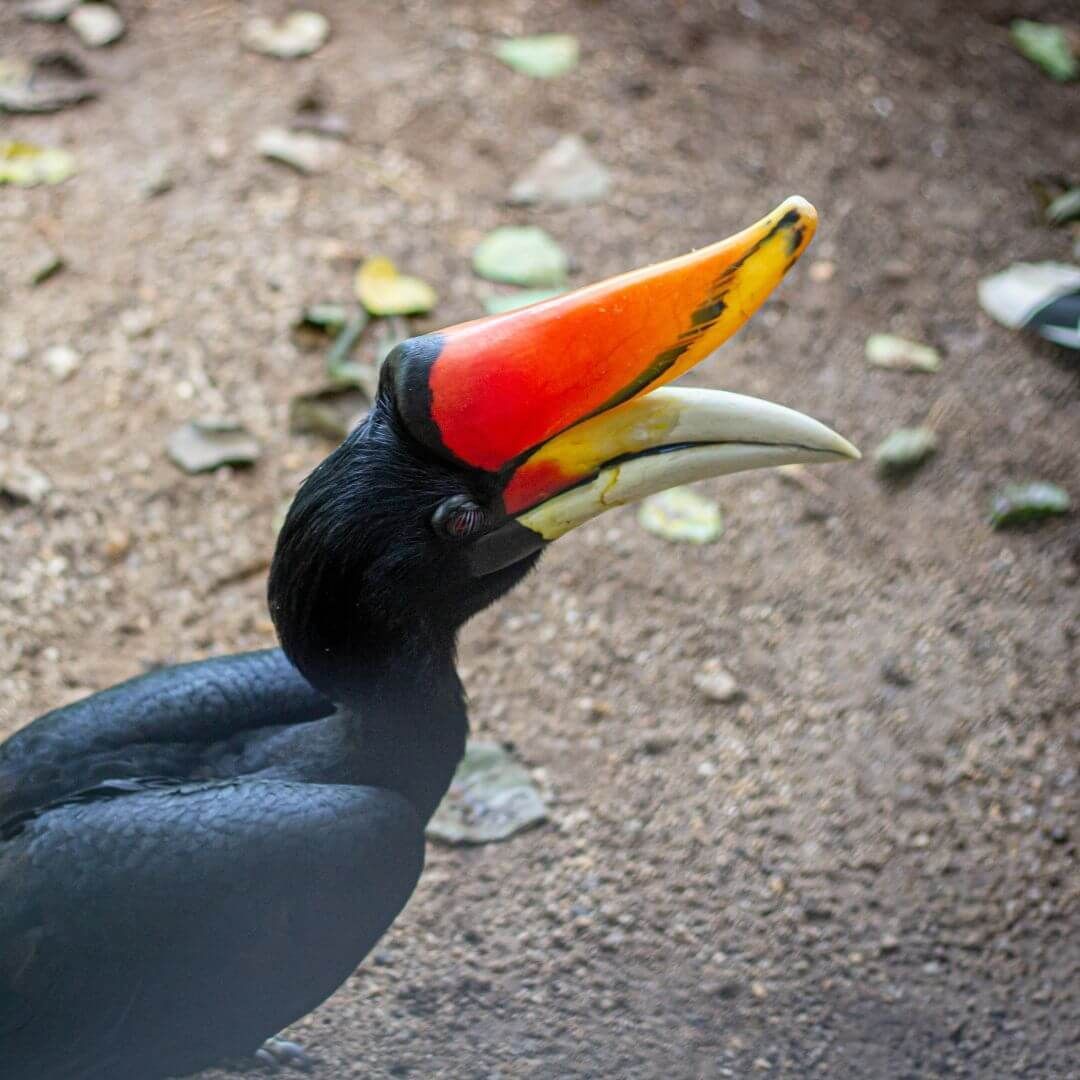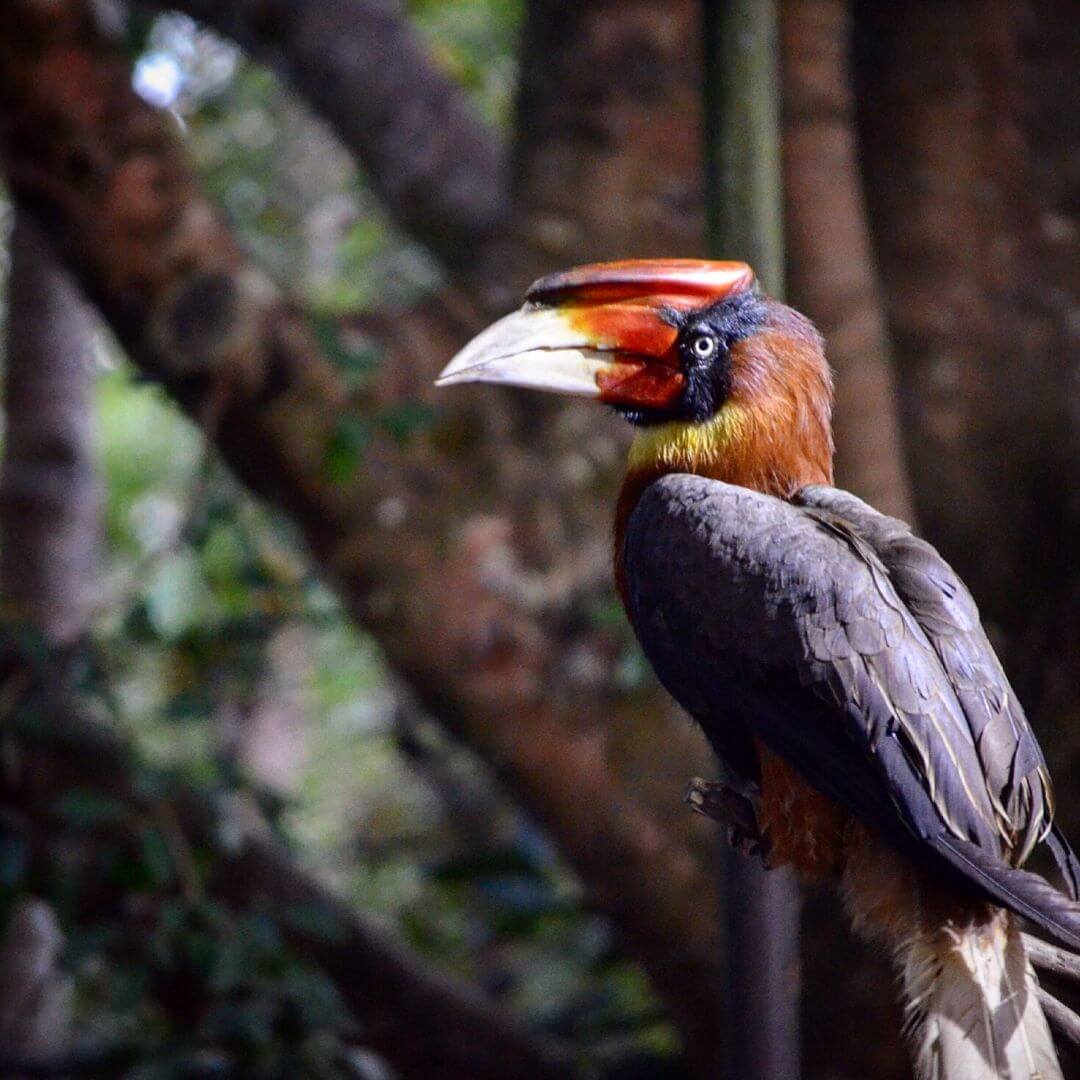Rhinoceros Hornbill

Let's Learn About Rhinoceros Hornbills
Word of the Week
Casque
Hornbills have a large structures on their beak called a casque. Scientists hypothesize its main purpose is to make their calls louder.
Cassowaries also have casques on their head.
Fast Facts

Where do rhinoceros hornbills live?
Rhinoceros hornbills live in Southeast Asia and on many islands, such as Borneo and Sumatra.
They are found in lowland rainforest where they rely on large trees for food and shelter.
What do rhinoceros hornbills eat?
Rhinoceros hornbills are omnivores, though most of their diet is fruit.
Rhinoceros hornbills rely heavily on fruit, such as figs, for food. They also eat small reptiles, birds, and mammals when they have the opportunity.


What traits do hornbills share?
There are more than 50 species of hornbills. Most hornbills...
- Have a long, colorful beak.
- Have a casque on their beak.
- Have an omnivorous diet.
- Are monogamous (only have one mate).
- Nest in tree cavities or on cliffs.
How many rhinoceros hornbills are there?
Rhinoceros hornbills are vulnerable to extinction.
Because of their large, hard-to-visit range, scientists do not have a population estimate for rhinoceros hornbills exist in the wild. Their population has been shrinking due to threats like deforestation and hunting.

Species Spotlight
Hornbills
Family: Bucerotidae
Hornbills are a family of birds. They are named for the horn-like structure on their beak. There are roughly 55 species found throughout Africa and Asia. Some species, like rhinoceros hornbills, are found in tropical forests. Other species, like ground hornbills, are found in open woodlands or savannas.
Hornbills are omnivores, meaning they eat both plants and animals. Hornbills in forests eat mostly fruit, so we call them frugivores. They spread seeds from fruit trees all around the forest in their waste. Hornbill species that live in open areas eat more meat than those that live in forests. Hornbills use their long, colorful beaks to pluck fruit and small animals, then tip their heads back and toss the food up to eat it.
The horn-like structure on the bill of hornbills is called a casque. Not every species has a casque, and, for some species, it is very small. Large casques are mostly hollow. One species, the helmeted hornbill, has a solid casque made of “hornbill ivory.” Scientists hypothesize that small casques help to strengthen the upper bill while large casques help amplify sound or impress mates.
What Threats Do Hornbills Face?
Unfortunately, many hornbills are endangered because of habitat loss (like deforestation) and poaching. Many hornbill species rely on large, old-growth trees for food and nesting sites. As deforestation destroys forest habitats, hornbills have less food and fewer nesting sites available.
Hornbills are also hunted for their unique casques, beaks, and feathers. Hornbills that have large casques, like the rhinoceros hornbill, or unique casques, like the helmeted hornbill, are targeted by poachers. The best way we can protect hornbills is by protecting forests. Buying locally produced products and using less paper are great ways to start.
BRAIN BLAST
Research hornbills! Select three interesting species and describe why you find them interesting.
Conservation Corner
Artificial Nest Boxes
Rhinoceros hornbills, great hornbills, pied hornbills, and many other hornbill species need very specific nesting sites. They require a cavity in the side of an old-growth tree high off the ground. These holes are usually formed by a branch falling off the tree, but they can sometimes be made by other birds, like woodpeckers. Once hornbills find a nest, they often return to it year after year to lay their eggs.
Deforestation in hornbill habitats has made finding a nesting site difficult. The available nesting sites disappear as the trees disappear. The population size of these hornbills will continue to shrink without a suitable place to raise chicks. In an effort to create more nesting sites for hornbills, scientists have started creating and placing artificial nest boxes in hornbill habitats!
The goal of this project is to create new nesting sites using boxes strapped to tall trees. However, creating the perfect hornbill nest box is challenging. Scientists worked to answer questions like…
- How do we make the nest box look like part of the natural habitat?
- How do we make the inside of the box feel like a tree cavity?
- What do we build the box out of?
- How do we attach it to the tree?
- How do we GET IT up into the tree?
- How will we monitor if a hornbill is using it?
Since the artificial nest box project began in 2013, more than 20 artificial nest boxes have been placed in hornbill habitat with motion-detecting cameras to keep track of any visitors to the nest. These artificial nests have been successfully used by several species of hornbills AND other animals like squirrels, bees, and civets. Scientists monitor each box closely to learn which are used most frequently. This helps scientists understand what hornbills prefer so we can keep making improvements!
Rhinoceros Hornbill Truths and Lies
Determine if each statement about rhinoceros hornbills is true or false?
Rhinoceros Hornbill Challenge
Design and build an artificial nest box for rhinoceros hornbill.
Learn More!
Glossary
Adaptation
The process by which a species becomes more fit for its environment over the course of several generations. It is a result of natural selection.
Artificial Nest Box
A structure built by people and added to a natural environment to offer more nesting sites to birds.
Beak
The extended jaw of a bird (also known as a bill).
Casque
A structure attached to the top of some bird species' bills (hornbills).
Deforestation
The process of removing trees by cutting them down to use their wood or burning them to make room for something else.
Frugivore
An animal that eats mainly fruit.
Monogamous
Having one single mate during the breeding season.
Old-Growth Forest
A very old forest ecosystem that has not be disturbed or destroyed by people.
Omnivore
An animal that eats both plants and animals.
Preening Gland
A gland located on a bird back near their tail that produces oil used to clean and water-proof feathers.
Rainforest
An ecosystem that receives a large amount of rain and has trees that form a closed canopy.
Seed Dispersal
The process of the seed being carried away from the mother plant.
Species
A closely related group of animals with similar characteristics that are capable of reproducing (example: tigers).
Sustainable
Something that is done in a way that protects the environment.
Tropical
Describing the region near the equator that is warm and humid.





